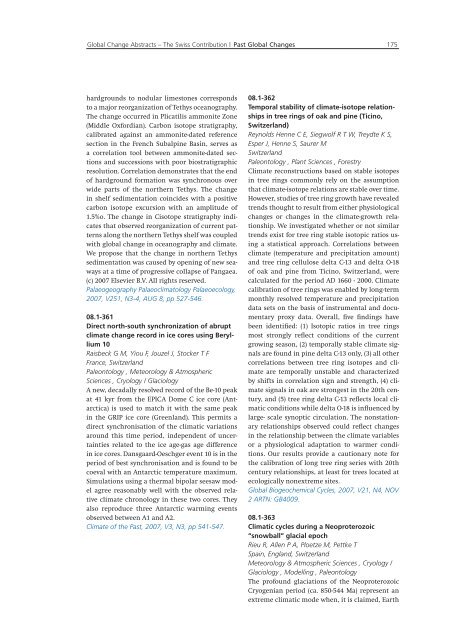Global Change Abstracts The Swiss Contribution - SCNAT
Global Change Abstracts The Swiss Contribution - SCNAT
Global Change Abstracts The Swiss Contribution - SCNAT
Create successful ePaper yourself
Turn your PDF publications into a flip-book with our unique Google optimized e-Paper software.
<strong>Global</strong> <strong>Change</strong> <strong>Abstracts</strong> – <strong>The</strong> <strong>Swiss</strong> <strong>Contribution</strong> | Past <strong>Global</strong> <strong>Change</strong>s<br />
hardgrounds to nodular limestones corresponds<br />
to a major reorganization of Tethys oceanography.<br />
<strong>The</strong> change occurred in Plicatilis ammonite Zone<br />
(Middle Oxfordian). Carbon isotope stratigraphy,<br />
calibrated against an ammonite-dated reference<br />
section in the French Subalpine Basin, serves as<br />
a correlation tool between ammonite-dated sections<br />
and successions with poor biostratigraphic<br />
resolution. Correlation demonstrates that the end<br />
of hardground formation was synchronous over<br />
wide parts of the northern Tethys. <strong>The</strong> change<br />
in shelf sedimentation coincides with a positive<br />
carbon isotope excursion with an amplitude of<br />
1.5%o. <strong>The</strong> change in Cisotope stratigraphy indicates<br />
that observed reorganization of current patterns<br />
along the northern Tethys shelf was coupled<br />
with global change in oceanography and climate.<br />
We propose that the change in northern Tethys<br />
sedimentation was caused by opening of new seaways<br />
at a time of progressive collapse of Pangaea.<br />
(c) 2007 Elsevier B.V. All rights reserved.<br />
Palaeogeography Palaeoclimatology Palaeoecology,<br />
2007, V251, N3-4, AUG 8, pp 527-546.<br />
08.1-361<br />
Direct north-south synchronization of abrupt<br />
climate change record in ice cores using Beryllium<br />
10<br />
Raisbeck G M, Yiou F, Jouzel J, Stocker T F<br />
France, Switzerland<br />
Paleontology , Meteorology & Atmospheric<br />
Sciences , Cryology / Glaciology<br />
A new, decadally resolved record of the Be-10 peak<br />
at 41 kyr from the EPICA Dome C ice core (Antarctica)<br />
is used to match it with the same peak<br />
in the GRIP ice core (Greenland). This permits a<br />
direct synchronisation of the climatic variations<br />
around this time period, independent of uncertainties<br />
related to the ice age-gas age difference<br />
in ice cores. Dansgaard-Oeschger event 10 is in the<br />
period of best synchronisation and is found to be<br />
coeval with an Antarctic temperature maximum.<br />
Simulations using a thermal bipolar seesaw model<br />
agree reasonably well with the observed relative<br />
climate chronology in these two cores. <strong>The</strong>y<br />
also reproduce three Antarctic warming events<br />
observed between A1 and A2.<br />
Climate of the Past, 2007, V3, N3, pp 541-547.<br />
175<br />
08.1-362<br />
Temporal stability of climate-isotope relationships<br />
in tree rings of oak and pine (Ticino,<br />
Switzerland)<br />
Reynolds Henne C E, Siegwolf R T W, Treydte K S,<br />
Esper J, Henne S, Saurer M<br />
Switzerland<br />
Paleontology , Plant Sciences , Forestry<br />
Climate reconstructions based on stable isotopes<br />
in tree rings commonly rely on the assumption<br />
that climate-isotope relations are stable over time.<br />
However, studies of tree ring growth have revealed<br />
trends thought to result from either physiological<br />
changes or changes in the climate-growth relationship.<br />
We investigated whether or not similar<br />
trends exist for tree ring stable isotopic ratios using<br />
a statistical approach. Correlations between<br />
climate (temperature and precipitation amount)<br />
and tree ring cellulose delta C-13 and delta O-18<br />
of oak and pine from Ticino, Switzerland, were<br />
calculated for the period AD 1660 - 2000. Climate<br />
calibration of tree rings was enabled by long-term<br />
monthly resolved temperature and precipitation<br />
data sets on the basis of instrumental and documentary<br />
proxy data. Overall, five findings have<br />
been identified: (1) Isotopic ratios in tree rings<br />
most strongly reflect conditions of the current<br />
growing season, (2) temporally stable climate signals<br />
are found in pine delta C-13 only, (3) all other<br />
correlations between tree ring isotopes and climate<br />
are temporally unstable and characterized<br />
by shifts in correlation sign and strength, (4) climate<br />
signals in oak are strongest in the 20th century,<br />
and (5) tree ring delta C-13 reflects local climatic<br />
conditions while delta O-18 is influenced by<br />
large- scale synoptic circulation. <strong>The</strong> nonstationary<br />
relationships observed could reflect changes<br />
in the relationship between the climate variables<br />
or a physiological adaptation to warmer conditions.<br />
Our results provide a cautionary note for<br />
the calibration of long tree ring series with 20th<br />
century relationships, at least for trees located at<br />
ecologically nonextreme sites.<br />
<strong>Global</strong> Biogeochemical Cycles, 2007, V21, N4, NOV<br />
2 ARTN: GB4009.<br />
08.1-363<br />
Climatic cycles during a Neoproterozoic<br />
“snowball” glacial epoch<br />
Rieu R, Allen P A, Ploetze M, Pettke T<br />
Spain, England, Switzerland<br />
Meteorology & Atmospheric Sciences , Cryology /<br />
Glaciology , Modelling , Paleontology<br />
<strong>The</strong> profound glaciations of the Neoproterozoic<br />
Cryogenian period (ca. 850-544 Ma) represent an<br />
extreme climatic mode when, it is claimed, Earth

















